RICH detectors get ready for heavy-flavour physics at the LHC.
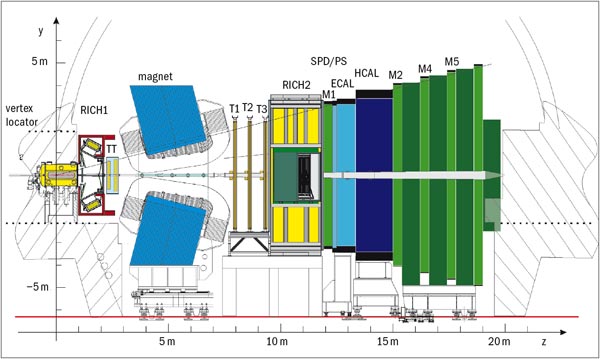
When the LHC starts up at CERN, it will provide proton collisions at higher energies than any previous accelerator and at high collision rates. While these conditions should reveal new high-energy phenomena, such as the Higgs mechanism and supersymmetry, they will at the same time open a different window onto new physics through the study of rare processes among existing particles in the Standard Model. This is the territory that the Large Hadron Collider beauty (LHCb) experiment will explore.
By undertaking precision studies of the decays of particles that contain heavy flavours of quarks (charm and beauty), LHCb will stringently test our knowledge of the Standard Model. In addition, these studies will search for new particles beyond the Standard Model through their virtual effects – just as the mass of the top quark was known well before it was directly observed. The results will provide a profound understanding of the physics of flavour and will cast more light on the subtle difference between matter and antimatter that is manifest in CP violation.
Good particle identification is a fundamental requirement
The LHCb detector looks very different from the average hadron collider detector – indeed, it looks more like a fixed-target detector (figure 1) – because of its focus on heavy flavour particles. This choice of detector geometry is motivated by the fact that, at high energies, both B(D) and B(D) hadrons are produced at predominantly low angles and in the same “forward” cone. The detector geometry is optimized to detect these forward events efficiently.
LHCb’s physics programme depends on being able to distinguish between the particle species produced so good particle identification is a fundamental requirement. The LHCb detector contains calorimeters and muon chambers to identify electrons, photons and muons. But to separate pions, kaons and protons in selected decays, a powerful different technique comes into play. This is the ring imaging Cherenkov (RICH) detector, first proposed at CERN in 1977 by Jacques Séguinot and Tom Ypsilantis, who was a member of the LHCb collaboration until his death in 2000.
The basic idea is that when a charged particle passes through a medium faster than the speed of light in that medium, it will emit Cherenkov radiation (named after the 1958 Nobel prize winner Pavel Cherenkov, who was the first to characterize the radiation rigorously). The effect is like a shock wave of light similar to the sonic boom of an aircraft travelling faster than the speed of sound.
This radiation is emitted at an angle to the direction of motion of the particle, forming a cone of light around the particle’s track. The angle of emission, θ, depends on the velocity of the particle but not on its mass, with cosθ = 1/nβ, where n is the refractive index of the medium and β is the velocity relative to the velocity of light in free space, c. Combining this velocity information with a measurement of the momentum of the particle (using tracking detectors and a known magnetic field), yields the mass of the particle and therefore its identity.
The simplest Cherenkov detectors are threshold devices that only produce a signal if the velocity of a charged particle exceeds the minimum necessary to produce Cherenkov radiation in a particular medium, or “radiator”. Taken together with a momentum measurement, this allows particles that are heavier than a certain mass to be separated from lighter ones. Such detectors have been employed in many experiments since the 1950s, for example in the classic detection of the antiproton at Berkeley – an experiment in which the young Ypsilantis participated.
Rings and radiators

The RICH detector is a far more sophisticated development. In a RICH device, the cone of Cherenkov light emitted in the radiator is detected on a position-sensitive photon detector. This allows the reconstruction of a ring or disc, the radius of which depends on the emission angle, θ, and hence on the velocity of the particle. In the RICH used by LHCb, the photons are collected by a spherical mirror and focused onto an array of photon detectors at the focal plane (figure 2 shows the principal in LHCb’s RICH1 detector). By focusing the radiation, the photons will form a ring with a radius that depends on the emission angle, θ, but not on where the light is emitted along the particle track.
The choice of which radiator to use is crucial, as every medium has a restricted velocity range over which it can usefully identify particles. Too low a velocity, and the particle will produce no light; too high, and the Cherenkov angle for all particle species will saturate to a common value, making identification impossible. It was therefore important for LHCb to choose a medium, or combination of different media, that would be effective over the full momentum range of interest – from around 1 GeV/c, up to and beyond 100 GeV/c. To achieve this coverage, the experiment uses a combination of three radiators – aerogel, perfluoro-n-butane (C4F10) and carbon tetrafluoride (CF4).
Silica aerogel is a colloidal form of quartz solid, but with an extremely low density and a high refractive index (1.01–1.10), which makes it perfect for the lowest-momentum particles (order of a few GeV/c). One of the key design issues for LHCb was the use of aerogel in ring-imaging mode. This was a new idea, inspired by the development of much higher-quality, very clear aerogel (figure 3). Previously, the material had only been used in threshold counters. To cover the regions of medium and high momentum, LHCb uses a combination of C4F10 and CF4 radiators for momenta from around 10 GeV/c to around 65 GeV/c, and from around 15 GeV/c to more than 100 GeV/c, respectively.
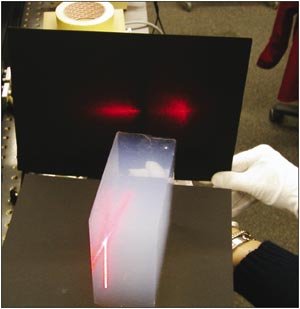
The early design of the system had three separate detectors, one for each radiator, but for a variety of reasons it proved more practical to combine the aerogel and C4F10 radiators into a single device with wide acceptance. This is the RICH1 detector, which is located upstream to detect the low-momentum particles (figure 1). The CF4 radiator is housed in RICH2, downstream of the tracking system and the LHCb magnet. This has an acceptance that is limited to the low-angle region where there are mostly high-momentum particles.
One challenge in both cases, was to minimize the amount of material within the detector acceptance. Therefore, the designs were changed at an early stage to tilt the focusing mirrors slightly and to introduce secondary flat mirrors that bring the Cherenkov radiation right out of the detector acceptance. This allows for a smaller photon-detector area and a more compact system.
A more radical redesign took place later, as the engineering designs for the various subdetectors became more realistic. It became clear that LHCb had too much material and needed re-designing. The challenge was also to improve the trigger performance by increasing the precision of the momentum measurement, and this required increasing the magnetic field in the region of the VErtex LOcator (VELO) and the trigger tracker (TT) between RICH1 and the dipole magnet (see figure 1).
While RICH2 remained relatively unaffected, RICH1 underwent a major redesign. To protect the sensitive photon detectors from the greatly increased magnetic field, extremely heavy iron shielding had to be added to the apparatus. Accommodating these shields in the very congested region of LHCb’s experimental area near RICH1 was a major challenge.
Seeing the light
Particles produced in the collisions in LHCb will travel through the mirrors of RICH1 prior to reaching measurement components further downstream. To reduce the amount of scattering, RICH1 uses special lightweight spherical mirrors constructed from a carbon-fibre reinforced polymer (CFRP), rather than glass. There are four of these mirrors, each made from two CFRP sheets moulded into a spherical surface with a radius of 2700 mm and separated by a reinforcing matrix of CFRP cylinders. The overall structure contributes about 1.5% of a radiation length to the material budget of RICH1. As RICH2 is located downstream of the tracking system and magnet, glass could be used for its spherical mirrors, which in this case are composed of hexagonal elements (see cover).
Perhaps surprisingly, the “flat” secondary mirrors in the RICH detectors are not truly flat. Producing completely flat, but thin, mirrors is a difficult technological challenge because it is hard to maintain their rigidity over a long period of time. Instead, giving the mirrors a small amount of curvature (a radius of curvature greater than 600 m in RICH1 and around 80 m in RICH2), increases their structural integrity. The small distortions that this curvature introduces to the images of the Cherenkov ring can be corrected with software during data analysis, and therefore do not degrade the final performance of the system.
The experiment requires 484 tubes in total
Both RICH detectors use hybrid photon detectors (HPDs) to measure the positions of the emitted Cherenkov photons. The HPD is a vacuum photon detector in which a photoelectron, released when an incident photon converts within a photocathode, is accelerated by a high voltage of typically 10–20 kV onto a reverse-biased silicon detector. The tube focuses the photoelectron electrostatically – with a demagnification factor of around five – onto a small silicon detector array.
The LHCb collaboration has developed a novel dedicated pixel–HPD for the RICH detectors, working in close co-operation with industry. Here, the silicon detector is segmented into 1024 “super” pixels, each 500 μm × 500 μm in area and arranged as a matrix of 32 rows and 32 columns. When a photoelectron loses energy in silicon, it creates electron-hole pairs at an average yield of one for every 3.6 eV of deposited energy. The nominal operating voltage of LHCb’s HPDs is –20 kV, corresponding to around 5000 electron-hole pairs released in the silicon. Careful design of read-out electronics and interconnects to the silicon detector results in a high efficiency for detecting single photoelectrons. The experiment requires 484 tubes in total – 196 for RICH1 and 288 for RICH2 – to cover the four detection surfaces.
Testing times
To verify the quality of the HPDs and the associated components in the low-level data acquisition (DAQ), the LHCb collaboration has conducted a series of RICH test-beam exercises, most recently during September 2006 in the North Area at CERN’s Prévessin site. In the test beam, the apparatus consisted of a gas vessel filled with either nitrogen (N2) or C4F10 as the radiator medium, together with a housing for the photo-detectors that was separated from the gas enclosure by a transparent quartz window. The test beam from the SPS consisted mainly of pions, with small contributions from electrons, kaons and protons, and had a 25 ns bunch-structure; the same as will be provided by the LHC.
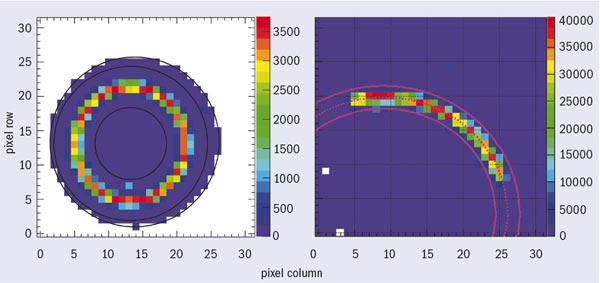
Columns of 16 HPDs observed the Cherenkov radiation emitted by the particles as they traversed the gas enclosure. The ring of Cherenkov light illuminated either one HPD, when using N2 as radiator, or up to four neighbouring HPDs with the C4F10 radiator (figure 4). The resulting data were recorded using final versions of the DAQ electronics and pre-production releases of the LHCb online software environment. An early version of the LHCb online-monitoring kept a check on the status of the test set-up and the quality of recorded data.
The analysis of the recorded test-beam data using the full LHCb reconstruction and analysis software involved a significant effort, but the results made it worthwhile. The tests verified the design specifications of the HPDs in a “real life” environment, with the measurement of properties such as the photoelectron yield and the resolution of the Cherenkov angle reconstructed from the data. Using the official LHCb software framework for the analyses also allowed the quality of the software to be verified with real data, so the team could spot any issues not seen in earlier simulation studies. The evaluation of the beam-tests indicates so far that all the hardware and software components involved in the tests match – or exceed – expectations, successfully passing an important milestone on the way to the start-up of the LHCb experiment.
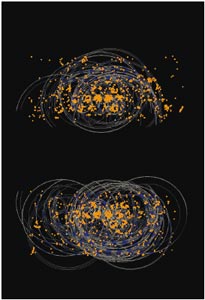
The full LHCb detector has been extensively modelled in a detailed simulation, based on the Geant4 software package, taking into account all important aspects of the geometry and materials together with a full description of the optics of the RICH detectors. This has provided a platform for the development of sophisticated analysis software to reconstruct the events and provide excellent particle identification. Figure 5 shows an example of the complex event environment that LHCb will face in collisions at the LHC. To disentangle the event, the analysis performs a combined likelihood-fit to all known tracks in the event. By considering all tracks and radiators in a single fit, the algorithm naturally accounts for the most predominant background to a given ring, namely the neighbouring rings.
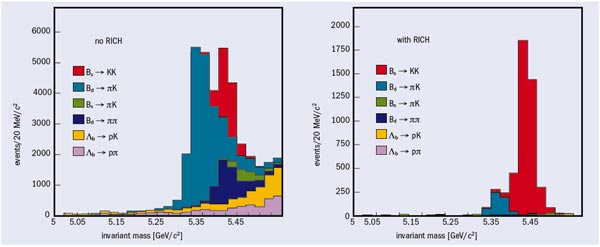
Figure 6 illustrates just how powerful this technique is. Here, using the detailed Geant4 simulations, the mass peak for the decay BS → KK is shown, together with the background contributions from other two-body decays. Without the kaon identification capabilities provided by the RICH detectors, the BS signal is swamped by background. Such efficient hadron identification will be a crucial component in the successful analysis of LHCb data.
Currently, the RICH group is fully focused on the commissioning of the RICH detectors at the experimental area at Point 8 on the LHC ring. The RICH2 detector is completely installed and the HPDs and readout systems are being commissioned. The magnetic shielding and radiator enclosure for RICH1 is in place and installation of all HPDs and optics will be completed later this year. Commissioning of the detector control and safety systems, together with the readout DAQ systems is also progressing at full speed. Everything is on track to have the system fully functional and ready for action for first data in 2008.








